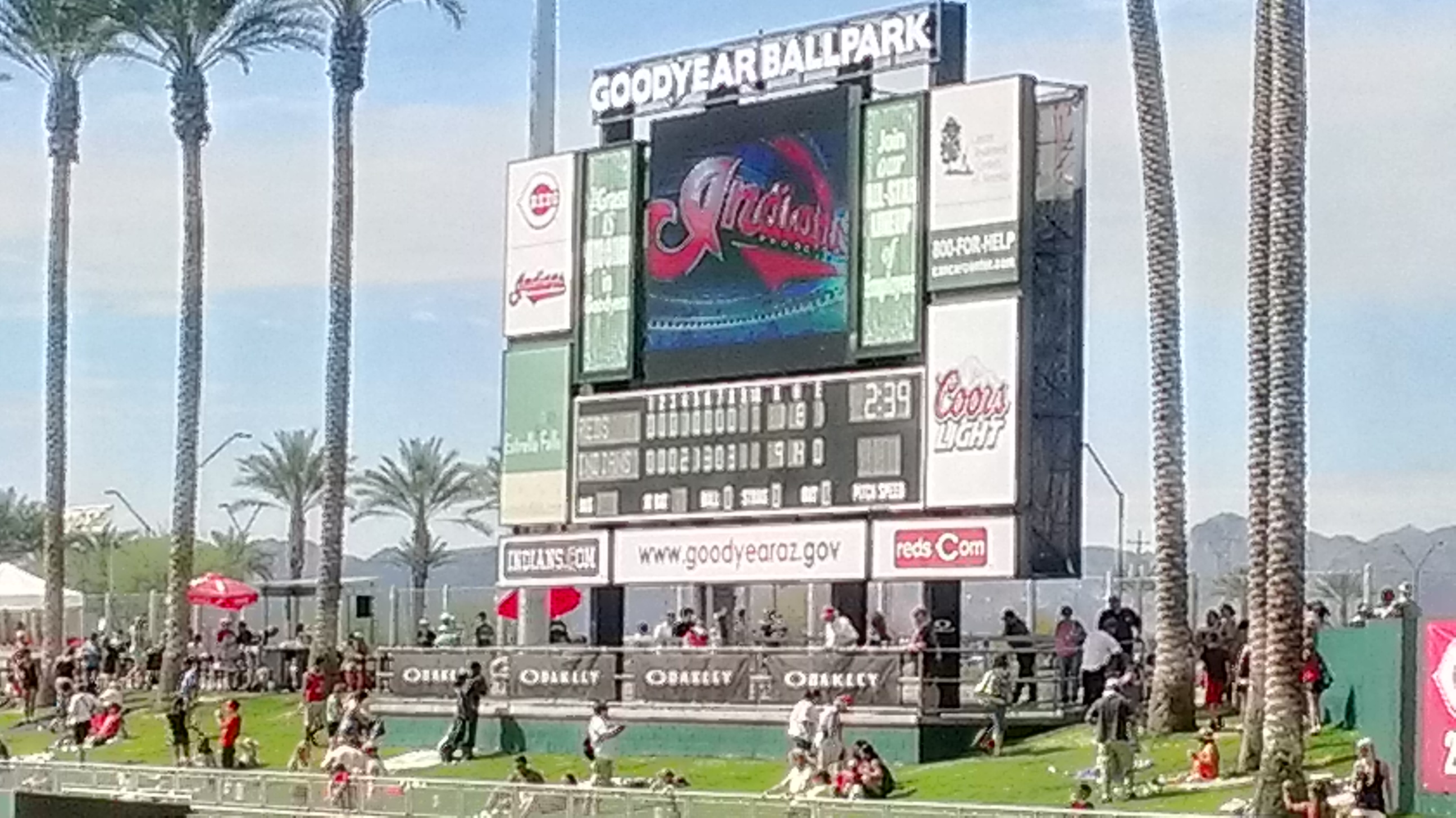 As long as everyone walked off the field healthy, you had to consider the Indians Cactus League finale a success. The Opening Day lineup made a cameo against a talented bunch of baseball players that could be labeled the Cincinnati Reds in name only, a squad split from manager Dusty Baker and a the familiar group of names that make up the actual roster of a team that many expect to win the National League Central Division this year.
As long as everyone walked off the field healthy, you had to consider the Indians Cactus League finale a success. The Opening Day lineup made a cameo against a talented bunch of baseball players that could be labeled the Cincinnati Reds in name only, a squad split from manager Dusty Baker and a the familiar group of names that make up the actual roster of a team that many expect to win the National League Central Division this year.
As final scores go, this one was 9-1 in favor of the Indians, but a great deal of the damage was done while I assume those making the trip to Toronto to start playing games that count on Tuesday were cleaning out their lockers because they had better things to worry about, like packing for Cleveland. Michael Bourn doubled in the contest, as did Carlos Santana, in addition to hitting his second home run of a spring interrupted by his duties with the Dominican Republic team in the World Baseball Classic. Asdrubal Cabrera started the game at shortstop, struck out once and walked once before letting Dorssys Paulino take over in the third inning; it was his first game action with the Tribe since being scratched last Sunday, due to back spasms.

33 games taught us a lot, but you certainly can’t get a good read on what exactly was learned by looking at the standings, or even a breakdown of Spring Training statistics. Now that everything is said and done, I’d like to breakdown what I saw with my own eyes in Arizona over the last 5 weeks.
The Starting Rotation
In what was supposed to be somewhat of an open competition between Justin Masterson and Ubaldo Jimenez, the decision for whom would get the ball on Opening Day was a quick call for the Tribe’s first year skipper. Both looked sharp against the Athletics on February 25th, but Francona told Masterson the next morning that it would be him on April 2nd, surprising no one. Masterson said that it was something he wanted, and that is was important to start things off on the right foot.
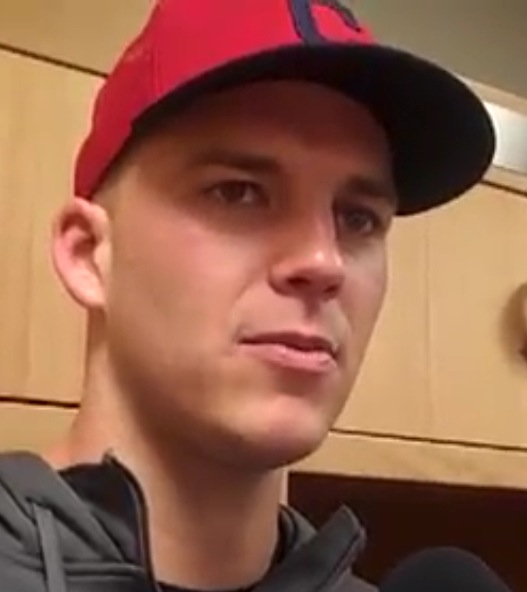
He did struggle twice, first with some technical problems in an outing against the White Sox, where his sinker was rising, according to Lou Marson. Masterson claimed that every one of Chicago’s six hits came on bad sinkers. The other bad outing, stat-wise, came on St. Patrick’s Day, when the Reds got him for 5 runs on 2 home runs. Francona claimed he had his best stuff to date in that one, and just got burnt leaving a couple up; it’s the type of thing you get away with on March 17th.
Jimenez struggled in his next few starts after a good outing in Phoenix against the A’s in February. He did settle in, as camp progressed, to finish with a 4.80 ERA over 30 innings in seven appearances. Now, Ubaldo would tell anyone willing to listen that he doesn’t concern himself with Spring Training numbers; he sang the same song a year ago, when he was 1-4 with a 7.43 ERA over 23 innings in 7 appearances, then he went out and led the American League in losses. The bottom line is that pitching when it doesn’t count is not a completely useless barometer for how you’re going to look when it does.
The final starter that entered camp with a basic understanding that he wasn’t battling for a roster spot is Brett Myers, used both as a starter and reliever by current third base coach for the lowly Astros over the last few season, but strictly as a reliever in 2012. Myers will tell you that he just loves playing this game, but the opportunity to start on this staff was still likely a factor in his decision to wear the Indians uniform this season. Myers does like to pitch to contact, so he likes it most when the hitters are swinging, meaning the box score should give you an idea of how he’s pitching. The stat sheet doesn’t bode well for Myers this spring if you go by his 9.00 ERA, which certainly was not aided by allowing the Rockies to smear him for 10 runs on 14 hits last Monday, while retiring just ten batters. His command was decent, but if he’s being hit hard, maybe you’d prefer he be giving up 1 base at a time with the free pass.
 The last two spots were up for grabs, but it was implied that one of those spots was Zach McAllister’s to lose. It took a few outings for Francona to let McAllister know that he didn’t lose the job, but on March 10th, after a week that saw him pitch well against the Cubs twice, to the tune of no runs on four hits over 7 innings of relief work. You try not to let March, let alone February, influence what you think of a pitcher, regardless of the circumstances, but McAllister threw a few decent innings at the Reds on February 24th, one of the coldest days of Cactus League play. One assumption about the desert is that it doesn’t get cold, but the truth is many parts of the Phoenix area saw snow just two days before Cactus League play began on February 22nd. Of course, McAllister was hit hard on a nice warm day at the Rangers place in Surprise later that week.
The last two spots were up for grabs, but it was implied that one of those spots was Zach McAllister’s to lose. It took a few outings for Francona to let McAllister know that he didn’t lose the job, but on March 10th, after a week that saw him pitch well against the Cubs twice, to the tune of no runs on four hits over 7 innings of relief work. You try not to let March, let alone February, influence what you think of a pitcher, regardless of the circumstances, but McAllister threw a few decent innings at the Reds on February 24th, one of the coldest days of Cactus League play. One assumption about the desert is that it doesn’t get cold, but the truth is many parts of the Phoenix area saw snow just two days before Cactus League play began on February 22nd. Of course, McAllister was hit hard on a nice warm day at the Rangers place in Surprise later that week.
The real battle was for the fifth spot in the rotation spot; suitors included Trevor Bauer, Carlos Carrasco, David Huff, Scott Kazmir, Corey Kluber, and Daisuke Matsuzaka. Going in, they all had something going for them. For Bauer, it was the “it” factor, as he was a piece of the blockbuster trade that sent Shin-Soo Choo to Cincinnati. For Carrasco, it was time in the organization that might have given him the edge. Ditto for Huff, who is out of options, which may have played a role. Kazmir used to kill Francona’s Red Sox once upon a time, prompting his introduction to the former Tampa Bay Ray to be something along the lines of, “I used to hate you.” Kluber has put up decent numbers in AA and AAA since coming over from San Diego via trade, but needs to overwhelm everyone into believing he isn’t merely AAA talent. Lastly, the hero of the 2006 World Baseball Classic for Japan, Matsuzaka may have had the advantage, due to time spent with the Tribe manager in Boston; a lifetime ago, Boston paid $51 million just to talk to him.
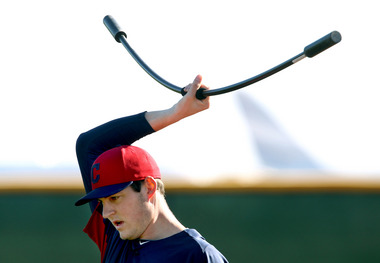 Bauer has the tools, but his usage this spring made it seem as if there was never really much doubt that he was destined for Columbus. The Diamondbacks did call him up, and quickly fell out of favor with their first round pick, enough to trade him for what feels like pennies on the dollar. He still has to learn to program himself to pitch the way a Major League team wants him to, and that’s a difficult maneuver to pull off while competing for a roster spot. Joining Bauer in Columbus will be Carlos Carrasco, rebounding from Tommy John surgery, who showed flashes this spring, but won’t be harmed by some time in the minors. He’ll officially start in the big leagues, only to serve a suspension, so there’s nothing to be read into with that. Corey Kluber did nothing in 3 appearances to lead the new coaching staff to believe he’s anything more than below average at the big league level, so he’ll also be starting the year in the International League.
Bauer has the tools, but his usage this spring made it seem as if there was never really much doubt that he was destined for Columbus. The Diamondbacks did call him up, and quickly fell out of favor with their first round pick, enough to trade him for what feels like pennies on the dollar. He still has to learn to program himself to pitch the way a Major League team wants him to, and that’s a difficult maneuver to pull off while competing for a roster spot. Joining Bauer in Columbus will be Carlos Carrasco, rebounding from Tommy John surgery, who showed flashes this spring, but won’t be harmed by some time in the minors. He’ll officially start in the big leagues, only to serve a suspension, so there’s nothing to be read into with that. Corey Kluber did nothing in 3 appearances to lead the new coaching staff to believe he’s anything more than below average at the big league level, so he’ll also be starting the year in the International League.
David Huff pitched pretty well on the day that McAllister solidified himself as the #4, but in the same breath that McAllister learned his fate, Huff was told they’d be trying him in the bullpen. A first-round choice in 2006, this was Huff’s last chance to make the team, and he’s just too “dime-a-dozen” to be on the Opening Day roster, even out of the bullpen, where he’s on a team that just doesn’t need a left-handed long man.
The pitcher that the media has come to know as “Dice-K” has earned a reputation for having some control issues, and though he prides himself in pitching his way out of jams, he was just being hit too hard this spring to be a viable option. He was brought in on a minor league contract, so he didn’t have to clear waivers and accepted a minor-league assignment after being released. Personally, I believed, based on the attention he still receives from the Japanese media, that his star might still shine a little too bright to try to bounce back thru the bus leagues, but I was wrong. He’s still in the organization, and you never know how he might help the club this season.
 Kazmir ended up being the man, and there wasn’t much mystery to that one either. Francona raved about how he loved the way the ball came out of the relatively small lefty’s hand. He’s not the crafty lefty, and he never attempted to re-invent himself as such, even out of the big leagues, playing with an independent team in Texas a year ago. After being on the verge of bust, if not a full-fledged bust, as a free agent with the Angels, the 29 year-old was mentally drained. He came to Goodyear on a minor-league deal and did little to disappoint. He did not allow a run until his fourth appearance, a 5-inning 5-run outing that spiked his ERA to 3.46 in Peoria against the Mariners last Saturday. It seemed like he was trying to get too cute with his pitches early, but settled in with his fastball as the game went on. He’s not going to be perfect this season, but he could easily settle in, and become one of the top 2 or 3 guys on the staff.
Kazmir ended up being the man, and there wasn’t much mystery to that one either. Francona raved about how he loved the way the ball came out of the relatively small lefty’s hand. He’s not the crafty lefty, and he never attempted to re-invent himself as such, even out of the big leagues, playing with an independent team in Texas a year ago. After being on the verge of bust, if not a full-fledged bust, as a free agent with the Angels, the 29 year-old was mentally drained. He came to Goodyear on a minor-league deal and did little to disappoint. He did not allow a run until his fourth appearance, a 5-inning 5-run outing that spiked his ERA to 3.46 in Peoria against the Mariners last Saturday. It seemed like he was trying to get too cute with his pitches early, but settled in with his fastball as the game went on. He’s not going to be perfect this season, but he could easily settle in, and become one of the top 2 or 3 guys on the staff.
Bullpen
The Indians bullpen is fairly established, with an understanding that it’s usually going to be Joe Smith in the 7th, Vinnie Pestano in the 8th, and Chris Perez to close it out in the 9th in a perfect world where the Indians have a late lead. Matt Albers, who came over from Arizona with fellow reliever Bryan Shaw in the Bauer deal, was virtually guaranteed a roster spot, being out of options, but he didn’t look anything near stellar in 8 appearances. Shaw was a little more unhittable in a spring that he entered with not guarantees, striking out 15 and allowing just 1 run in 11 innings of work. Both made the team, meaning Matt Capps was released, but he was brought back in the same fashion as Matsuzaka on the minor-league deal. I’d expect a steady diet of the former Diamondbacks to be the first men up in the bullpen, probably seeing Albers to start a fresh inning and Shaw with runners on.
Cody Allen threw eight scoreless innings last season before allowing his first Major League run to score, off the bat of Nick Swisher, which gave the 2011 Draft Pick his first Major League loss to the Yankees. He had a few rough days this spring, but did nothing to enter any doubt about his merit for a roster spot this year. Should anything happen to Smith, Pestano, or Perez, he’s likely the next man up for late inning work, but he’s got the type of stuff that makes him someone you want Francona to go to in clutch situations.
For the first time in a while, the Indians aren’t relying on lefties of the Tony Sipp or post-2007 Rafael Perez ilk. Rich Hill came in on a minor league deal and was added to the 40-man roster (bumping Blake Wood) after two weeks of games. Hill isn’t the 12-to-6 curveball pitcher he was with the Cubs many moons ago, but his left arm could give the Tribe an inning or two when necessary. Scott Barnes, Nick Hagadone, and eventually David Huff became other left-handed options, but Hagadone really owned it in Arizona, putting Barnes and Huff on a bus; where David Huff’s bus stops is anyone’s guess, but I doubt it stops at Ontario and Carnegie anytime soon.
Catcher
Whether its Mike Lieberthal or Jason Varitek, Terry Francona runs the whole show on defense through his catcher. That made it difficult to lose Carlos Santana for so much of Spring Training during the World Baseball Classic this year, but Santana doesn’t jump off the page at you as a defensive catcher. He’s a great athlete, so you know he might get there, if only because there aren’t any physical limitations, even if there are concerns with his ability to manage a pitcher. He’s got Sandy Alomar there to teach him, so there’s a chance with that, but he doesn’t need much help at the plate. The kid can hit, and we all know that, so his .333 average this spring with two HRs in 11 games should have come as no surprise.
It gets a little tricky with the backup backstop. Lou Marson wasn’t going to lose the job, but he’s a guy whose bat you don’t want in the lineup any more often than every fifth day. What you have in Marson is a career .220 hitter that has never really hit the ball well at any level in the Indians or Phillies system. He’s a good battery mate, but such a hole in the lineup that you wonder what else is there.
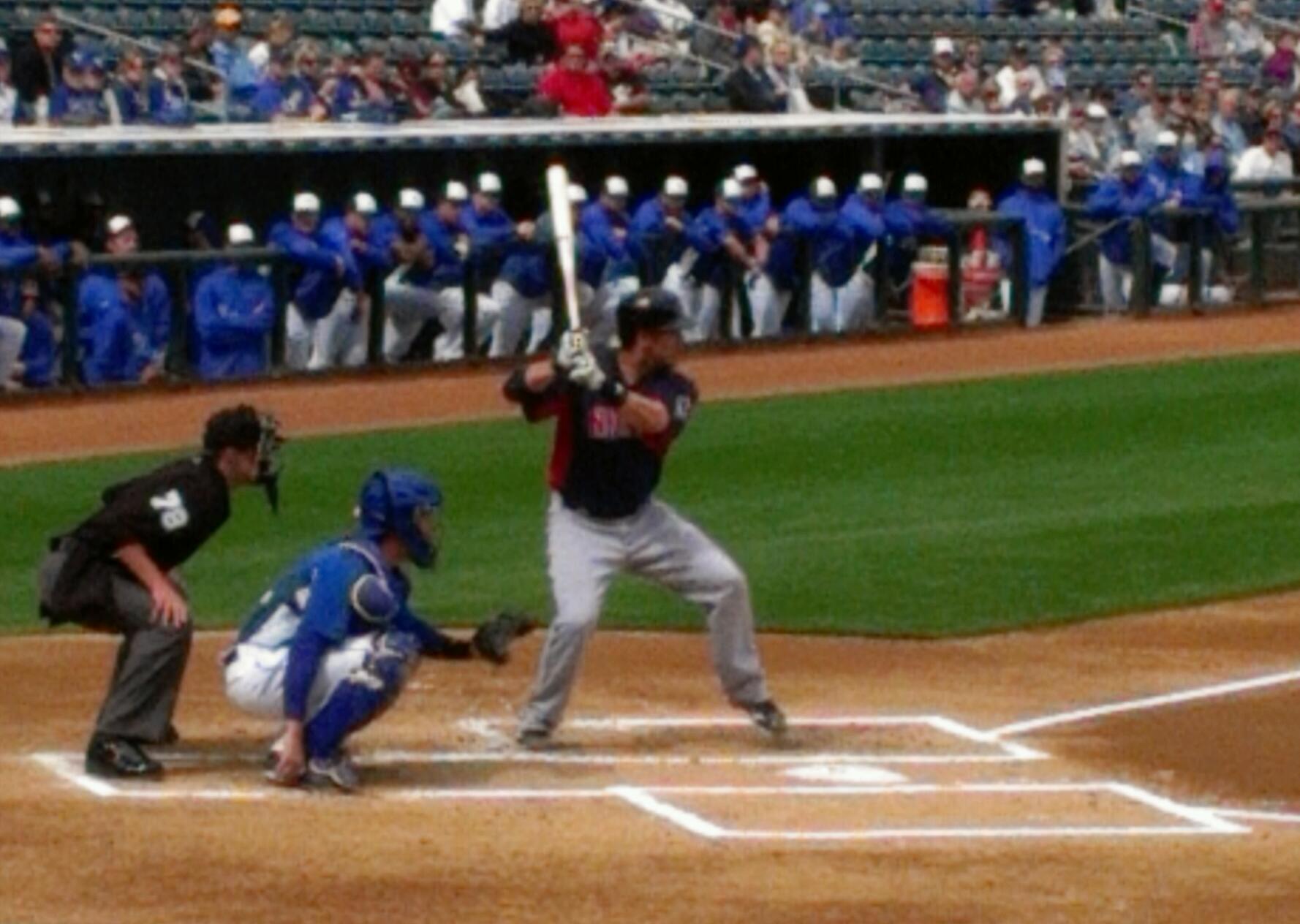 The Brazillian product Yan Gomes brings an interesting element to the table, who came over with Mike Aviles in the Esmil Rogers trade. The Blue Jays have tried him at 1st, 3rd, and at the corner outfield spots, but he brings the most value to the Indians as a catcher, where Cactus League fans saw plenty of him in Santana’s absence. In a very small sample size this spring, I saw a very good receiver with an average ability to gun down runners. Both Omir Santos and Roberto Perez appear to have the edge on him in that category, as far as defensive catchers go. What you like from Gomes is his ability to do what Marson cannot, and that is to “rake”. Gomes hit the ball hard; 6 of his 11 hits went for extra bases this spring, good for a .704 slugging percentage to accompany his .407 batting average. He will start the year in Columbus to get everyday at-bats, but there is more future in Gomes than there will ever be in Marson.
The Brazillian product Yan Gomes brings an interesting element to the table, who came over with Mike Aviles in the Esmil Rogers trade. The Blue Jays have tried him at 1st, 3rd, and at the corner outfield spots, but he brings the most value to the Indians as a catcher, where Cactus League fans saw plenty of him in Santana’s absence. In a very small sample size this spring, I saw a very good receiver with an average ability to gun down runners. Both Omir Santos and Roberto Perez appear to have the edge on him in that category, as far as defensive catchers go. What you like from Gomes is his ability to do what Marson cannot, and that is to “rake”. Gomes hit the ball hard; 6 of his 11 hits went for extra bases this spring, good for a .704 slugging percentage to accompany his .407 batting average. He will start the year in Columbus to get everyday at-bats, but there is more future in Gomes than there will ever be in Marson.
First Base
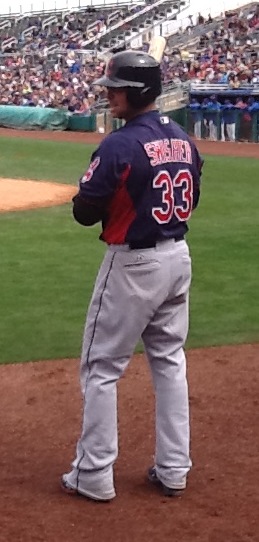
Second Base
At second base, Jason Kipnis appears to be a mainstay for years to come. He’s gotten a lot work this spring, appears to have shown some minor improvements defensively, and is learning a lot about hitting from Swisher and Jason Giambi. I’m weary of the inevitable sophomore slump from Kipnis, but that’s more about my gut than his 10-for-56 performance at the plate in these practice games. Only time will tell. Mike Aviles and Ryan Raburn, who both hit the ball well for the Puerto Rican team and the Indians, respectively, this spring are on the big league roster to back up the former Sun Devil outfielder, but the real prospects at the position are still a few years away. Cord Phelps had an excellent spring, probably actually outplayed Raburn, and was told by the club he did nothing wrong while also being told he’d start the year in AAA.
Shortstop
We didn’t see a lot of Asdrubal Cabrera this spring, who was away with the Venezuelan team in the WBC, then missed some time because of injury, but we don’t need Spring Training to tell us what to expect from Cabrera. He’s at the top of the order he’s expected to produce, and he’s expected to make plays at short, even if his UZR is supposed to tell us he can’t field his position better than Jhonny Peralta. Aviles is the only other reasonable option as shortstop, and even if his name doesn’t come up a lot, he he adds a lot of value to the team. Of course, I saw a lot more Juan Diaz than I would have in a year without the WBC. There are some really great players that might be the heir apparent to Cabrera, but Diaz isn’t one of them, even if he is likely the next man up in an emergency situation. Dorssys Paulino, Ronny Rodriguez, and Francisco Lindor are still a year or two away.
Third Base
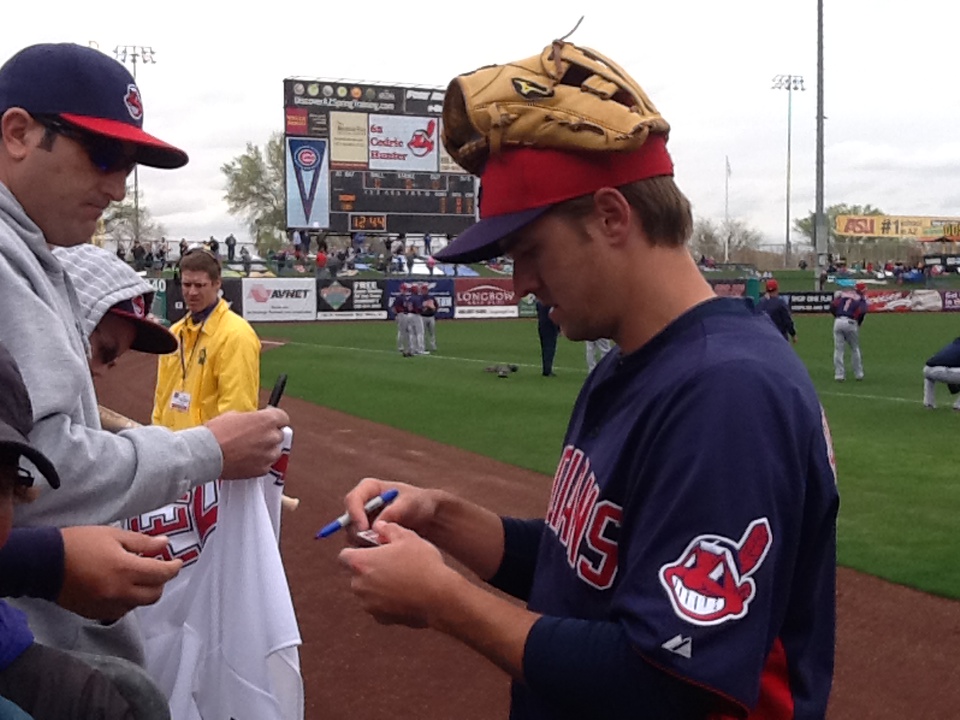
Outfield
In the outfield, it’s speed, defense, and more defense. Long forgotten are the days of Luis Valbuena being forced to play left field, or the square peg that is Ryan Garko being forced to fit in those round holed outfield positions. Back in December, Drew Stubbs felt like a throw-in, but he’s a legitimate right fielder who can swing the bat. There was a time when we thought Tim Fedroff would possibly have a role, especially the way he was hitting in AAA last summer, but along came Nick Swisher, then Michael Bourn at the 11th hour. Now, Swisher is just an option in the outfield in the same way that Ryan Raburn is. Truthfully, the Indians don’t have any true back-up outfielders, a convenience afforded them by the presence of three starters that can all play center field, a real rarity.
Bourn didn’t hit the ball all that well this spring, but that seems to be more about a new environment than something we should really worry about. Brantley, on the other hand, swung the bat particularly well every time up. Like Chisenhall, I expect big things from the Player to be Named Later in the CC Sabathia trade that will patrol left field this season. The pressure will be off him, hitting lower in the lineup, but I’m not even sure that’s necessary for a guy who can definitely hit in the clutch. I’m in the extreme minority here, but I found it unfortunate to see no place for Eziquiel Carrera on this bench. Don’t get me wrong; I understand the argument and agree that he doesn’t bring anything to this team that it doesn’t already have, but I think he’s a good spark off the bench. He doesn’t get on base enough, but he can create real live scoring with his speed on the basepaths, something you don’t get with Ryan Raburn. Also, I’d never heard of Matt Carson 2 months ago, but now I’m thinking he’ll have a role on this team in 2013, should he be called upon. The skinny on Carson is that he’s appeared in 72 games at the big league level since 2009 and has the ability to hit the long ball (5 this spring), but he strikes out too much.
Manager
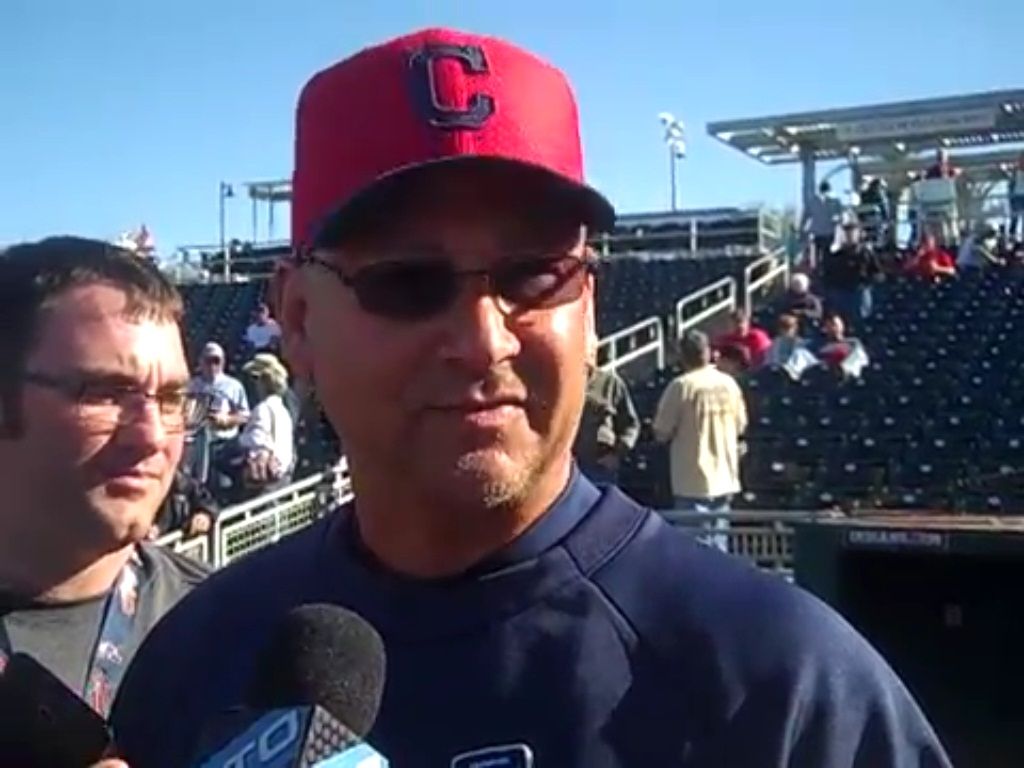 The X-Factor is, of course, Terry Francona. He’s got two World Series rings, and that earns him the benefit of the doubt under any and all circumstances. He doesn’t lock the clubhouse down with childish rules, demands respect, and expects everyone’s best effort every time out. Spring Training doesn’t present game situations that require a manager to be a true strategist, but Tito has the rings to prove he can handle what’s thrown his way. It’s purely coincidental that I expect this team’s regular season record to reflect its slightly above .500 Spring Training record, but that’s how I see it. You can look at it one of two ways; either the starting pitching is going to neutralize a decent offense or the excellent offense won’t have enough to overcome the inconsistent starting pitching.
The X-Factor is, of course, Terry Francona. He’s got two World Series rings, and that earns him the benefit of the doubt under any and all circumstances. He doesn’t lock the clubhouse down with childish rules, demands respect, and expects everyone’s best effort every time out. Spring Training doesn’t present game situations that require a manager to be a true strategist, but Tito has the rings to prove he can handle what’s thrown his way. It’s purely coincidental that I expect this team’s regular season record to reflect its slightly above .500 Spring Training record, but that’s how I see it. You can look at it one of two ways; either the starting pitching is going to neutralize a decent offense or the excellent offense won’t have enough to overcome the inconsistent starting pitching.
Call it six of one, a half dozen of the other, if you want to count it. Any way you go about it, none of what we saw counts for anything, but it all counts for everything on Tuesday, when you can throw all of this speculation out the window.